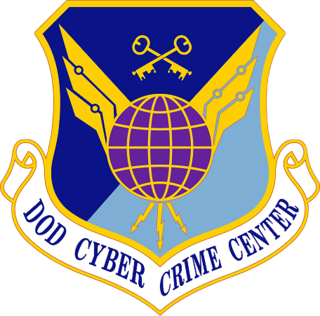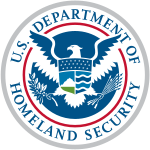
The United States Department of Homeland Security (DHS) is the U.S. federal executive department responsible for public security, roughly comparable to the interior or home ministries of other countries. Its stated missions involve anti-terrorism, border security, immigration and customs, cyber security, and disaster prevention and management.
The United States Computer Emergency Readiness Team (US-CERT) is an organization within the Department of Homeland Security’s (DHS) Cybersecurity and Infrastructure Security Agency (CISA). Specifically, US-CERT is a branch of the Office of Cybersecurity and Communications' (CS&C) National Cybersecurity and Communications Integration Center (NCCIC).

The National Cyber Security Division (NCSD) is a division of the Office of Cyber Security & Communications, within the United States Department of Homeland Security's Cybersecurity and Infrastructure Security Agency. Formed from the Critical Infrastructure Assurance Office, the National Infrastructure Protection Center, the Federal Computer Incident Response Center, and the National Communications System, NCSD opened on June 6, 2003. The NCSD mission is to collaborate with the private sector, government, military, and intelligence stakeholders to conduct risk assessments and mitigate vulnerabilities and threats to information technology assets and activities affecting the operation of the civilian government and private sector critical cyber infrastructures. NCSD also provides cyber threat and vulnerability analysis, early warning, and incident response assistance for public and private sector constituents. NCSD carries out the majority of DHS’ responsibilities under the Comprehensive National Cybersecurity Initiative. The FY 2011 budget request for NCSD is $378.744 million and includes 342 federal positions. The current director of the NCSD is John Streufert, former chief information security officer (CISO) for the United States Department of State, who assumed the position in January 2012.

The Homeland Security Act (HSA) of 2002, was introduced in the aftermath of the September 11 attacks and subsequent mailings of anthrax spores. The HSA was cosponsored by 118 members of Congress. The act passed the U.S. Senate by a vote of 90–9, with one Senator not voting. It was signed into law by President George W. Bush in November 2002.

In the U.S., critical infrastructure protection (CIP) is a concept that relates to the preparedness and response to serious incidents that involve the critical infrastructure of a region or the nation. The American Presidential directive PDD-63 of May 1998 set up a national program of "Critical Infrastructure Protection". In 2014 the NIST Cybersecurity Framework was published after further presidential directives.

The Chemical and Biological Defense Division (CBD) is a division of the Science and Technology Directorate of the United States Department of Homeland Security. Within the Homeland Security Advanced Research Projects Agency, CBD develops technologies to increase the United States's preparedness and protect key national infrastructure against chemical, biological, and agricultural threats and disasters through improved threat awareness and advanced surveillance, detection, and protective countermeasures.

The Infrastructure Protection and Disaster Management Division (IDD) is a division of the Science and Technology Directorate of the United States Department of Homeland Security. Within the Homeland Security Advanced Research Projects Agency, IDD develops technologies to improve and increase the United States' strategic preparedness response to natural and man-made threats through situational awareness, emergency response capabilities, and critical infrastructure protection.

The Department of Defense Cyber Crime Center (DC3) is designated as a Federal Cyber Center by National Security Presidential Directive 54/Homeland Security Presidential Directive 23, as a Department of Defense (DoD) Center Of Excellence for Digital and Multimedia (D/MM) forensics by DoD Directive 5505.13E, and serves as the operational focal point for the Defense Industrial Base (DIB) Cybersecurity program. DC3 operates as a Field Operating Agency (FOA) under the Inspector General of the Department of the Air Force.

The Under Secretary of Homeland Security for Science and Technology is a high level civilian official in the United States Department of Homeland Security. The Under Secretary, as head of the Science and Technology Directorate at DHS, is the principal staff assistant and adviser to both the Secretary of Homeland Security and the Deputy Secretary of Homeland Security for all DHS technological research.

The Command, Control and Interoperability Division is a bureau of the United States Department of Homeland Security's Science and Technology Directorate, run by Dr. David Boyd. This division is responsible for creating informative resources(including standards, frameworks, tools, and technologies) that strengthen communications interoperability, improve Internet security, and integrity and accelerate the development of automated capabilities to help identify potential threats to the U.S.
The Stephenson Disaster Management Institute at Louisiana State University is located in the Stephenson National Center for Security Research and Training at LSU.

Dr. Paul N. Stockton is the President of Paul N Stockton LLC, a strategic advisory firm in Santa Fe, NM. From 2009-2013, Dr. Stockton served as Assistant Secretary of Defense for Homeland Defense and Americas' Security Affairs, where he helped lead the Department's response to Hurricane Sandy. He was responsible for Defense Critical Infrastructure Protection, Western Hemisphere security policy, domestic crisis management, continuity of operations planning, and a range of other responsibilities. While Assistant Secretary, Dr. Stockton also served as Executive Director of the Council of Governors. After serving as Assistant Secretary, Dr. Stockton was the Managing Director of Sonecon LLC, an advisory firm in Washington, DC, from 2013-2020.

The Critical Infrastructure Research and Development Advancement Act of 2013 is a bill that would require the United States Department of Homeland Security (DHS) to transmit to the Congress a strategic plan for research and development efforts addressing the protection of critical infrastructure and a report on departmental use of public-private consortiums to develop technology to protect such infrastructure. The bill also would direct the Government Accountability Office (GAO), within two years of enactment, to evaluate the effectiveness of clearinghouses established by DHS to share technological innovation.

The National Cybersecurity and Critical Infrastructure Protection Act of 2013 is a bill that would amend the Homeland Security Act of 2002 to require the Secretary of the Department of Homeland Security (DHS) to conduct cybersecurity activities on behalf of the federal government and would codify the role of DHS in preventing and responding to cybersecurity incidents involving the Information Technology (IT) systems of federal civilian agencies and critical infrastructure in the United States.

The Homeland Security Cybersecurity Boots-on-the-Ground Act is a bill that would require the United States Department of Homeland Security (DHS) to undertake several actions designed to improve the readiness and capacity of DHS’s cybersecurity workforce. DHS would also be required to create a strategy for recruiting and training additional cybersecurity employees.
The Cyber Resilience Review (CRR) is an assessment method developed by the United States Department of Homeland Security (DHS). It is a voluntary examination of operational resilience and cyber security practices offered at no cost by DHS to the operators of critical infrastructure and state, local, tribal, and territorial governments. The CRR has a service-oriented approach, meaning that one of the foundational principles of the CRR is that an organization deploys its assets to support specific operational missions. The CRR is offered in a facilitated workshop format and as a self-assessment package. The workshop version of the CRR is led by a DHS facilitator at a critical infrastructure facility. The workshop typically takes 6–8 hours to complete and draws on a cross section of personnel from the critical infrastructure organization. All information collected in a facilitated CRR is protected from disclosure by the Protected Critical Infrastructure Information Act of 2002. This information cannot be disclosed through a Freedom of Information Act request, used in civil litigation, or be used for regulatory purposes. The CRR Self-Assessment Package allows an organization to conduct an assessment without the need for direct DHS assistance. It is available for download from the DHS Critical Infrastructure Cyber Community Voluntary Program website. The package includes an automated data answer capture and report generation tool, a facilitation guide, comprehensive explanation of each question, and a crosswalk of CRR practices to the criteria of the National Institute of Standards and Technology (NIST) Cybersecurity Framework. The questions asked in the CRR and the resulting report are the same in both versions of the assessment. DHS partnered with the CERT Division of the Software Engineering Institute at Carnegie Mellon University to design and deploy the CRR. The goals and practices found in the assessment are derived from the CERT Resilience Management Model (CERT-RMM) Version 1.0. The CRR was introduced in 2009 and received a significant revision in 2014.
The National Cybersecurity and Communications Integration Center (NCCIC) is part of the Cybersecurity Division of the Cybersecurity and Infrastructure Security Agency, an agency of the U.S. Department of Homeland Security. It acts to coordinate various aspects of the U.S. federal government's cybersecurity and cyberattack mitigation efforts through cooperation with civilian agencies, infrastructure operators, state and local governments, and international partners.
Dr. Phyllis Schneck is an American executive and cybersecurity professional. As of May 2017, she became the managing director at Promontory Financial Group. Schneck served in the Obama administration as Deputy Under Secretary for Cybersecurity and Communications for the National Protection and Programs Directorate (NPPD), at the Department of Homeland Security.

The Cybersecurity and Infrastructure Security Agency (CISA) is an agency of the United States Department of Homeland Security (DHS) that is responsible for strengthening cybersecurity and infrastructure protection across all levels of government, coordinating cybersecurity programs with U.S. states, and improving the government's cybersecurity protections against private and nation-state hackers. Its activities are a continuation of the National Protection and Programs Directorate (NPPD), and was established on November 16, 2018, when President Donald Trump signed into law the Cybersecurity and Infrastructure Security Agency Act of 2018.
Operational collaboration is a cyber resilience framework that leverages public-private partnerships to reduce the risk of cyber threats and the impact of cyberattacks on United States cyberspace. This operational collaboration framework for cyber is similar to the Federal Emergency Management Agency (FEMA)'s National Preparedness System which is used to coordinate responses to natural disasters, terrorism, chemical and biological events in the physical world.







